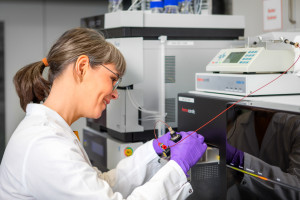The aim of the Multi-Omics research programme is to develop bioanalytical and computational technologies for prognostic, diagnostic, and predictive biomarkers. The scientists research methods which can be used to more effectively to detect markers in complex biological matrices. These biological markers are intended for cardiovascular diseases (CVDs), cancer, and metabolic disorders.
Most diseases are caused by the deregulation of metabolic and signalling pathways at different molecular levels, from genes to lipids to proteins and metabolites. The regulation of metabolic pathways and their interaction with environmental factors requires the use of multiple analytical methods for the detection of proteins, lipids, metabolites, and their dynamics. A single analytical technology is neither sufficient for a comprehensive understanding of select biological model systems, nor for identifying biomarkers. In view of the huge number of potential analytes in biological systems, all measurements need to be carried out to a high degree of precision. That is why a multi omics approach, a combination of different omics – meaning addressing the entire characterisation of all genes (genomics), metabolites (metabolomics) or proteins (proteomics) – approach is needed.
Multi omics strategies: indispensable for precision medicine
Omics technologies are an important starting point in personalised therapies (precision medicine). On the one hand, they produce multi-dimensional data sets (in unprecedented quality), which bring insights into disease processes and potential treatment approaches. On the other hand, multi omics data sets for non-directional analyses can be used to demonstrate new correlations (generating new hypotheses) between various molecule classes. However, these large and complex data sets also need to be managed adequately.

One of the main focus areas: omics approaches for CVDs
Regarding CVDs, many factors including genetic predisposition, gut microbiome, lifestyle, and environmental factors, can have an impact. In addition, current therapeutic approaches to tumour diseases and inflammations can have side effects on the cardiovascular system. ISAS’ Multi Omics programme therefore particularly focuses on developing multi omics technologies and assays with regard to heart attacks (myocardial infarction), heart failure, cardiotoxicity, and cardio-oncology. With omics-integrative models and the combination of lipidomic, proteomics, and metabolomic data, and by using graph databases and AI, researchers at ISAS aim to gain comprehensive insights into CVDs' complex molecular aspects. The analytical challenges that the scientists are tackling include molecular coverage, analytical sensitivity, data integration, and interpretation, as well as issues related to data quality, reproducibility, and standardisation.
Besides developing technologies to shed light on molecular mechanisms and identify biomarkers, the programme addresses the identification of new therapeutic targets. Therefore, unravelling the molecular mechanisms underlying CVDs is crucial. Systems biology approaches using multi omics data play a critical role in identifying cellular changes and signalling events associated with disease genesis and progression.
High-throughput / high-resolution technologies with new bioinformatic strategies
In general, multi omics technologies comprise analytical methods which can be used to investigate biomolecules from tissue samples or other biological samples like blood at a global level. Scientists at ISAS devote their time to developing such tools for integrating multi omics data sets. They combine various analysis techniques such as electrospray ionization mass spectrometry (ESI-MS), MALDI (Matrix Assisted Laser Desorption/Ionization), light and fluorescence microscopy, and they develop new bioinformatic strategies for data analyses.